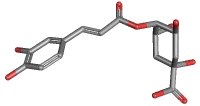|
CRYPTOCHLOROGENIC ACID |
| Synonyms. Cryptochlorogenic acid; 4-O-Caffeoylquinic acid; 4-O-(3,4-Dihydroxycinnamoyl)-D-quinic acid; (3S,5S)-4-[(E)-3-(3,4-dihydroxyphenyl)prop-2-enoyl]oxy-1,3,5-trihydroxycyclohexane-1- carboxylic acid; 3,4-Dihydroxycinnamic acid 4-carboxy-2,4,6-trihydroxycyclohexyl ester; (1alpha,3alpha,4alpha, 5beta) -4- (3-(3,4-(Dihydroxyphenyl) -1-oxo-2-propenyl)oxy)-1,3,5- trihydroxy cyclohexanecarboxylic acid; |
|
|
| PRODUCT IDENTIFICATION | |
|
CAS RN |
905-99-7 |
|
EINECS RN |
|
|
FORMULA |
C16H18O9 |
|
MOLE WEIGHT |
354.31 |
|
H.S CODE |
2918.29.6500 |
|
SMILES |
C1[C@@H](C([C@H](CC1(C(=O)O)O)O)OC(=O)/C=C/C2=CC(=C(C= C2 )O)O)O |
|
CLASSIFICATION |
Hydroxycinnamic acid, Choleretic |
|
EXTRA NOTES |
Cryptochlorogenic acid (4-O-Caffeoylquinic acid) is an isomer of chlorogenic acid and possesses antioxidant properties. |
|
|
| PHYSICAL AND CHEMICAL PROPERTIES | |
|
PHYSICAL STATE. |
white powder |
|
MELTING POINT |
182 ~ 184 C |
|
BOILING POINT |
|
|
DENSITY |
1.65 |
|
SOLUBILITY IN WATER |
Soluble in hot water |
| SOLVENT SOLUBILITY | Soluble in alcohol |
|
VAPOR DENSITY |
|
|
log P(octanol-water) |
|
|
VAPOR PRESSURE |
|
|
AUTOIGNITION TEMP |
|
| pK |
|
|
REFRACTIVE INDEX |
|
|
FLASH POINT |
|
|
|
| STABILITY AND REACTIVITY | |
| STABILITY | Stable under normal conditions. |
|
INCOMPATIBLE MATERIALS |
Strong oxidizing agents. |
| POLYMERIZATION |
Has not been reported |
|
NFPA RATINGS |
Health: 1, Flammability: 0, Reactivity: 0 |
|
|
| EXTERNAL LINKS & GENERAL DESCRIPTION |
|
Wikipedia Linking - Cryptochlorogenic acid Google Scholar Search - 4-O-Caffeoylquinic acid Drug Information Portal (U.S. National Library of Medicine) - Cryptochlorogenic acid PubChem Compound Summary - Cryptochlorogenic acid KEGG (Kyoto Encyclopedia of Genes and Genomes) - Cryptochlorogenic acid http://www.ebi.ac.uk/ - Cryptochlorogenic acid http://www.ncbi.nlm.nih.gov/ - Cryptochlorogenic acid Journal of Chromatography |
|
|
| SALES SPECIFICATION | |
|
APPEARANCE |
white crystalline powder |
|
ASSAY |
98.0% min |
|
OPTICAL ROTATION |
-71.0° ~ -81.0° (c=0.5 in H2O) |
|
LOSS ON DRYING |
3.0% max |
|
HEAVY METALS |
20ppm max |
|
|
| TRANSPORT & REGULATORY INFORMATION | |
|
UN NO. |
Not regulated |
| HAZARD CLASS |
|
| PACKING GROUP | |
|
|
| SAFETY INFORMATION |
|
|
HAZARD OVERVIEW |
May cause eye and skin irritation. May cause respiratory and digestive tract irritation. Target Organs: Not known. |
| HAZARD CODES |
|
|
RISK PHRASES |
|
|
SAFETY PHRASES |
24/25 |
|
|
| PACKING |
|
Preserve in light-resistant and well-closed containers |
